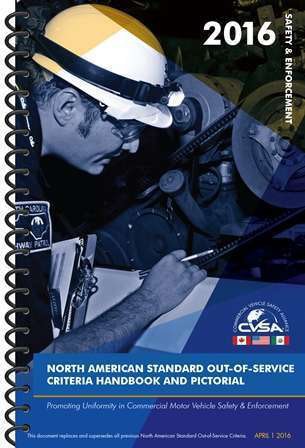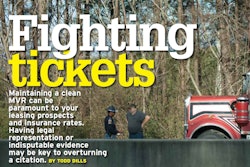I came across a brief piece on page 4 in the Commercial Vehicle Safety Alliance’s Guardian quarterly publication, after talking for a bit with Andy Blair, a former officer/certified inspector currently in fleet safety part-time with Kinsley Construction. He also consults for a variety of fleets and owner-operators in the region around York, Pa., where he’s based, and occasionally farther afield (the consulting involves, usually, Level 1-equivalent inspections of a fleet’s trucks, or presentations to company staff, sometimes including drivers, on inspections).
Blair wrote the story in Guardian, and it’s a discussion of his use of the out-of-service criteria handbook that CVSA publishes. Part of the organization’s mission is the establishment of those criteria, and the annual revision of them as well.

“So a pig tail coming out is now an OOS violation for lights,” Kurt Keilhofer wrote. “Does this mean when most of the letters in the OPEN or CLOSED sign for the scale are not working, the scale can be put OOS until it is repaired?”

If only.
More seriously, Allan McCullough noted that, as has been argued for years by others, the electronic version of the book ought to be free, particularly if CVSA is really “concerned about safety,” as McCullough put it. (Yote Anders, for his part, suggested a different potential source of revenue, one that, moved in the right direction, might eliminate a lot of the equipment violations that are associated with many OOS conditions: “Why don’t they get rid of some DOT officers and use the money to fix the roads.”)
Free or not, Blair himself argues that any motor carrier — including independents with their authority — will benefit from having the out of service criteria readily at hand. “It’s $45 to buy one of these books,” he says, digital or print (Blair likes the print himself). In the case of any out-of-service violation you receive, compare the associated inspection report, he says, to the book itself, and depending on the circumstances, you could be like as not to find a basis for challenging the violation through the DataQs system and getting it removed from the company record.
That record, of course, remains readily available for all to see via the altered CSA Safety Measurement System, though percentile scores still aren’t available pending independent study and potential revamp. (Law enforcement can still see and use them, of course, though practices vary considerably: a friend in rural Tennessee recently told me a story of getting stopped and going through a Level 3 inspection. When the officer looked up the driver’s DOT number and pulled up his employing carrier’s profile, he called out, “What’s it mean when a bunch of exclamation marks pop up on my computer?” The driver threw up his hands, but those exclamation points could well be the result of an overabundance of out-of-service violations in various CSA SMS categories, where they’re getting extra weighting in the points system.)
The OOS book, Blair contends, is much easier to use, too, than the big green book of regs. As he writes in the Guardian, as an officer, he …
… used the OOS criteria handbook much more than the general regulations. Finding information out about tire violations, for instance, would require hunting them down in 49 CFR using the long index or just flipping pages. When you finally locate the correct section, it is all typed pages of information with no diagrams, photos, guides or easy-to-read paragraphs. The 49 CFR regulations book looks like an old phone book. Lots of information, but not easy to read …
… or digest. The OOS handbook’s index is simpler and more useful, he adds, and pictures/diagrams illustrating many OOS conditions provide useful tools. The book “also includes the 49 CFR reference [for any OOS condition] and should you need to check further into the regulations, you can easily at least locate the right chapter,” Blair writes.
While the online variant of the regulations has gotten better for searchability, in some ways addressing the issues Blair brings up about the big green book, it’s still difficult to find what you want or fully understand given the lack of context for much of the regulatory information.
As it is, the OOS book is $45 ($35 if you’re a CVSA member), but if it saves you once from an out-of-service violation on your record, it might well have returned its investment, if not the downtime/expense incurred in the moment. CVSA actually typically makes public its annual updates, so annotations to the print version for reference are possible without buying a new copy every year.
At once, you could always write Blair if you’ve got a question about a particular violation. He says he’s open to it: [email protected].













